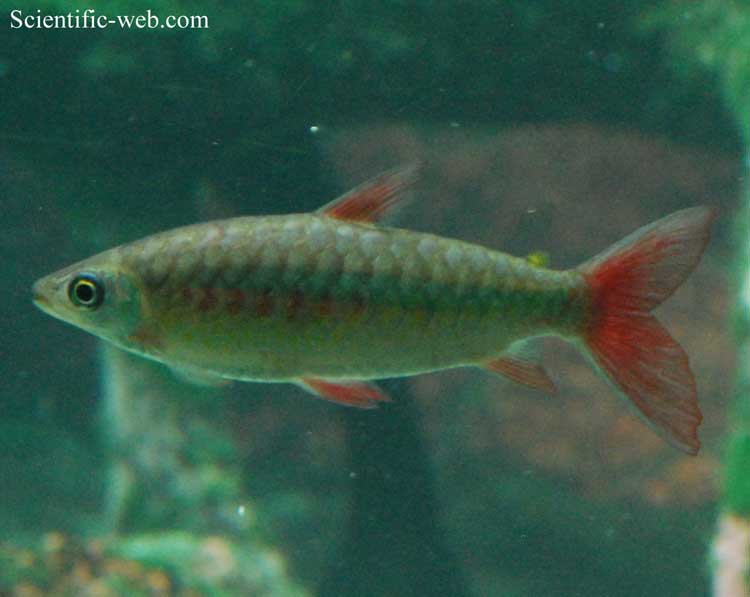
Chalceus erythrurus, Photo: Michael Lahanas
Superregnum: Eukaryota
Cladus: Unikonta
Cladus: Opisthokonta
Cladus: Holozoa
Regnum: Animalia
Subregnum: Eumetazoa
Cladus: Bilateria
Cladus: Nephrozoa
Superphylum: Deuterostomia
Phylum: Chordata
Subphylum: Vertebrata
Infraphylum: Gnathostomata
Megaclassis: Osteichthyes
Superclassis/Classis: Actinopterygii
Classis/Subclassis: Actinopteri
Subclassis/Infraclassis: Neopterygii
Infraclassis: Teleostei
Megacohors: Osteoglossocephalai
Supercohors: Clupeocephala
Cohors: Otomorpha
Subcohors: Ostariophysi
Sectio: Otophysa
Ordo: Characiformes
Familia: Chalceidae
Genus: Chalceus
Species: Chalceus erythrurus
Name
Chalceus erythrurus (Cope, 1870)
References
Chalceus erythrurus – Taxon details on Integrated Taxonomic Information System (ITIS).
Vernacular names
português: Ariri
The tucan fish (Chalceus erythrurus),[1][2] also called the yellowfin chalceus,[3][4] is a species of freshwater fish in the family Chalceidae. It is one of five species in the genus Chalceus, and was the second species to be described therein.
Description
The tucan fish has a pale-silver body, with bright-yellow ventral fins (hence its other common name); the rest of its fins are some mixture of yellow and red, usually with a reddish tail fin.[5] In terms of size, it reaches 21.4 cm SL.[1] This makes it one of the larger members of the genus Chalceus, outsized only by the pinktail chalceus.
Etymology
The name "tucan fish" directly translates to "toucan fish", as "tucán" means toucan in Spanish.[6] All members of the family Chalceidae are sometimes referred to as tucanfishes, but C. erythrurus is the species to which it is most often applied.[7]
The genus name Chalceus is Greek, and means brass or copper.[1] The specific name erythrurus also originates in Greek, with "eruthros" meaning red and "ouros" meaning tail in reference to its caudal fin usually being reddish.[8]
Taxonomy
Upon being described by Edward Drinker Cope in the year 1870, the tucan fish was placed in the new genus Plethodectes with the full name Plethodectes erythrurus.[9] However, Cope switched it over to the genus Chalceus in the year 1872.[10]
It was briefly classified as Chalceus macrolepidotus iquitensis, a subspecies of the pinktail chalceus C. macrolepidotus, by Shoji Nakashima in 1941.[11] Henry Watson Fowler described it as Pellegrinina heterolepis in 1907, but Jacques Géry proved it to be a member of the Chalceus genus in 1977.[12][13]
The name Chalceus erythrurus was once mistakenly applied to C. macrolepidotus, and they are sometimes confused with one another.[14] They can be told apart because of the tucan fish's bright-yellow ventral fins, as well as a few other coloration patterns.[5]
Habitat
The tucan fish can be found in the Amazon and Solimões rivers, and its habitat extends into Peru by way of the Ucayali river.[1][13]
Diet and behavior
Like others in the genus Chalceus, the tucan fish is primarily a carnivore, targeting aquatic invertebrates (such as insects and crustaceans).[15] It is known to be somewhat skittish, and may jump out of the water on occasion.[3]
References
Froese, Rainer; Pauly, Daniel (eds.) (2021). "Chalceus erythrurus" in FishBase. December 2021 version.
"ADW: Chalceus erythrurus: CLASSIFICATION". animaldiversity.org. Retrieved 2021-12-25.
"Yellowfin Chalceus (Chalceus erythrurus)". Aqua-Imports. Retrieved 25 December 2021.
Waller, Sara. "Yellow Fin Chalceus (Chalceus erythrurus)". Aquarium Life Support Systems. Retrieved 26 December 2021.
"Chalceus, Cuvier, 1817". Plazi TreatmentBank. Retrieved 26 December 2021.
"Translation of tucán – Spanish-English dictionary". Cambridge Dictionary. Cambridge University Press. Retrieved 26 December 2021.
Froese, Rainer, and Daniel Pauly, eds. (2021). "Chalceidae" in FishBase. December 2021 version.
Scharpf, Christopher; Lazara, Kenneth J. (15 September 2020). "Order CHARACIFORMES: Families IGUANODECTIDAE, TRIPORTHEIDAE, BRYCONIDAE, CHALCEIDAE and GASTEROPELECIDAE". The ETYFish Project. Retrieved 26 December 2021.
Cope, Edward Drinker (1870). "Contribution to the Ichthyology of the Maranon". Proceedings of the American Philosophical Society. 11 (81): 563–564. Retrieved 26 December 2021.
Cope, Edward Drinker (1872). "On the fishes of the Ambyiacu River". Proceedings of the Academy of Natural Sciences of Philadelphia. 23: 262. Retrieved 26 December 2021.
Nakashima, Shoji (1941). "Algunos peces del Oriente perauno" (PDF). Boletin de Museo Historia Natural "Javier Prado". 16: 62–63. Retrieved 26 December 2021.
Fowler, Henry Weed (1906). "Further Knowledge of some Heterognathous Fishes". Proceedings of the Academy of Natural Sciences of Philadelphia. 58: 442–444. Retrieved 26 December 2021.
Zanata, A.M.; and M. Toledo-Piza (2004). "Taxonomic revision of the South American fish genus Chalceus Cuvier (Teleostei: Ostariophysi: Characiformes) with the description of three new species". Zoological Journal of the Linnean Society. 140 (11): 103–135. doi:10.1111/j.1096-3642.2004.00090.x.
"Pink-tailed Characin". Tropical Freshwater Fish. Mongabay. Retrieved 24 December 2021.
"Chalceus erythrurus (Tucanfish)". Seriously Fish. Retrieved 26 December 2021.
Retrieved from "http://en.wikipedia.org/"
All text is available under the terms of the GNU Free Documentation License

